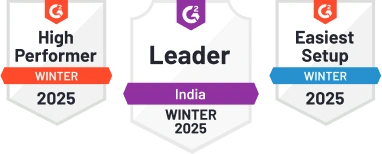Grab a chance to avail 6 Months of Performance Module for FREE
Book a free demo session & learn more about it!
-
Will customized solution for your needs.
-
Empowering users with user-friendly features.
-
Driving success across diverse industries, everywhere.
Grab a chance to avail 6 Months of Performance Module for FREE
Book a free demo session & learn more about it!
Superworks
Modern HR Workplace
Your Partner in the entire Employee Life Cycle
From recruitment to retirement manage every stage of employee lifecycle with ease.



Seamless onboarding & offboarding
Automated compliance & payroll
Track performance & engagement
Customer Satisfaction Manager KRA/KPI
- Key Responsibility Areas (KRA) & Key Performance Indicators (KPI) for Customer Satisfaction Manager
- 1. Customer Feedback Management
- 2. Service Quality Improvement
- 3. Customer Relationship Management
- 4. Escalation Handling
- 5. Team Training and Development
- 6. Process Optimization
- 7. Customer Experience Analysis
- 8. Data-Driven Decision Making
- 9. Stakeholder Communication
- 10. Continuous Improvement Initiatives
- Real-Time Example of KRA & KPI
- Customer Feedback Management
- Key Takeaways
Key Responsibility Areas (KRA) & Key Performance Indicators (KPI) for Customer Satisfaction Manager
1. Customer Feedback Management
KRA: Managing customer feedback to enhance service quality and satisfaction levels.
Short Description: Improving customer feedback processes.
- Net Promoter Score (NPS)
- Customer Satisfaction Score (CSAT)
- Number of Positive Reviews
- Resolution Time for Negative Feedback
2. Service Quality Improvement
KRA: Ensuring continuous improvement in service quality standards.
Short Description: Enhancing service quality metrics.
- Service Level Agreement (SLA) Compliance
- First Contact Resolution Rate
- Customer Wait Time
- Service Error Rate
3. Customer Relationship Management
KRA: Building and maintaining strong relationships with customers.
Short Description: Strengthening customer relationships.
- Customer Retention Rate
- Upsell/Cross-sell Rate
- Customer Lifetime Value (CLV)
- Customer Referral Rate
4. Escalation Handling
KRA: Effectively managing escalated customer issues.
Short Description: Streamlining escalation processes.
- Escalation Resolution Time
- Escalation Closure Rate
- Customer Satisfaction Post-Escalation
- Escalation Trends Analysis
5. Team Training and Development
KRA: Training and developing the customer service team for improved performance.
Short Description: Enhancing team skills and knowledge.
- Training Hours per Employee
- Employee Satisfaction with Training
- Improved First Call Resolution Post-Training
- Quality Assurance Scores Post-Training
6. Process Optimization
KRA: Identifying and implementing process improvements for enhanced customer satisfaction.
Short Description: Streamlining operational processes.
- Process Efficiency Metrics
- Reduced Customer Complaints due to Process Changes
- Time Saved per Customer Interaction
- Process Error Rate Reduction
7. Customer Experience Analysis
KRA: Analyzing customer experiences to identify pain points and opportunities for enhancement.
Short Description: Improving overall customer experience.
- Customer Journey Mapping Completion
- Net Emotional Value (NEV) Score
- Customer Effort Score (CES)
- Implementation of Customer Experience Improvements
8. Data-Driven Decision Making
KRA: Utilizing data insights to make informed decisions for customer satisfaction strategies.
Short Description: Data-driven approach for decision-making.
- Utilization of Customer Analytics Tools
- Conversion Rate Optimization based on Data Analysis
- Customer Segmentation Effectiveness
- ROI on Data-Driven Initiatives
9. Stakeholder Communication
KRA: Effective communication with internal and external stakeholders to align customer satisfaction goals.
Short Description: Enhancing stakeholder relationships for customer focus.
- Stakeholder Feedback Integration
- Alignment of Stakeholder Expectations with Customer Needs
- Stakeholder Satisfaction Surveys
- Resolution Time for Stakeholder Issues
10. Continuous Improvement Initiatives
KRA: Driving continuous improvement initiatives based on feedback and performance metrics.
Short Description: Fostering a culture of ongoing improvement.
- Number of Implemented Improvement Suggestions
- Impact of Improvement Initiatives on Customer Satisfaction
- Employee Engagement in Improvement Activities
- Feedback Loop Efficiency
Real-Time Example of KRA & KPI
Customer Feedback Management
KRA: Implementing a real-time feedback system to capture customer sentiments immediately after service interactions.
- KPI 1: Percentage Increase in Positive Feedback Responses
- KPI 2: Average Time to Resolution for Critical Negative Feedback
- KPI 3: Net Promoter Score (NPS) Trends
- KPI 4: Feedback Response Rate
These KPIs led to a 15% increase in customer satisfaction scores and a 20% rise in repeat business within three months.
Key Takeaways
- KRA defines what needs to be done, whereas KPI measures how well it is done.
- KPIs should always be SMART (Specific, Measurable, Achievable, Relevant, Time-bound).
- Regular tracking and adjustments ensure success in Customer Satisfaction Manager roles.




